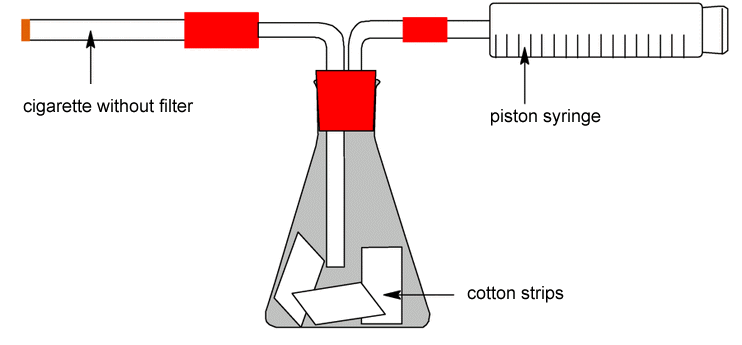|
2. Masking the Smell of Cigarette Smoke |
||||||
Provided that the test has been set up and the cotton strips soaked and dried again, the experiment can be performed in approx. 10 minutes. |
||||||
|
||||||
| The strong smelling components of cigarette smoke are encapsulated in a host-guest complex. Since most textile fresheners are scented, any remaining smell of smoke is masked by the fragrance. Cigarette manufacturers also make use of this capacity for odor absorption. Cellulose, the carrier in the cigarette filter, is treated with cyclodextrins so that some of the tar and nicotine is actually trapped in the filter. | ||||||
Before using textile fresheners in this experiment, it is advisable to perform the experiment to extract cyclodextrins from textile fresheners to test whether the selected household chemicals actually contain cyclodextrins. Remove the cigarette filter, since many cigarette filters contain cyclodextrins. One cigarette can fill 5 – 6 pistons with smoke, so several Erlenmeyer flasks can be used in this experiment. This experiment can also be used to test the cotton strips produced in the experiment on cyclodextrins in textile finishing, in addition to the cotton strips soaked in the β-cyclodextrin solution. |
||||||
Observations from this experiment have generated demand for textiles with cyclodextrin finishes that instantly neutralize the smell of cigarettes and other unpleasant odors. This demand could be satisfied at the start of this millennium with the introduction of a range of suits called “Fresh concept”, which Günther Yesuch arranged to be tested by office workers, a farmer and a refuse collector for his television programme Stern-TV (27.1.2001). |
||||||
 |
||||||
| Fig. 2.23: Textiles finished with cyclodextrins trap malodorous substances and make them odor-neutral | ||||||
However, unlike our experiment, the suit fabric has not been simply soaked in a cyclodextrin solution, because this type of impregnation is not permanent and would have to be renewed after every wash. To maintain the odor-absorbing affect even after several washes, the cyclodextrin molecules must be covalently bonded to the textile fibers. This is achieved by functionalizing the cyclodextrin molecule. The process is explained in the experiment on cyclodextrins in textile finishing. The encapsulated odors are released again during washing, leaving the cyclodextrins free to act as odor-absorbers again. The cyclodextrin molecules anchored to the textile fibers can also absorb organic components of perspiration, in addition to cigarette smoke. The microbial degradation of perspiration, which produces the unpleasant odors, is prevented or at least delayed. |
||||||
|
||||||
